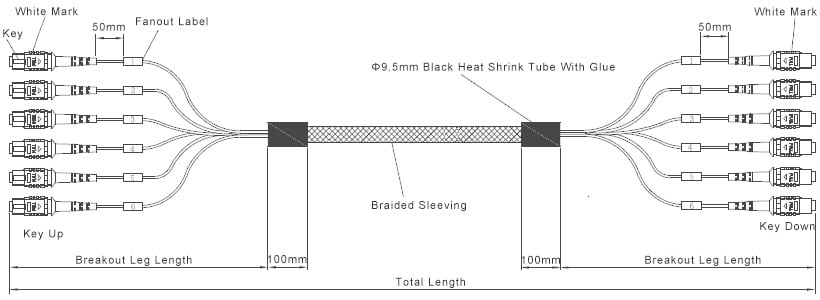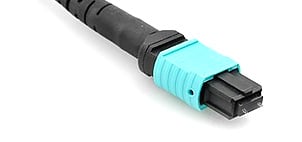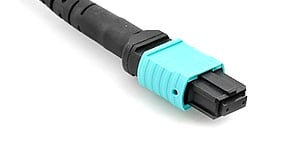72 Fibers Multimode OM1 12 Strands MPO Trunk Cable 3.0mm LSZH/Riser
FM SKU#:SKU0005K2
Model#:FM72OM1-2MPO-x
MFG PART#:
The data centra application with high dense degree environment
The optical fiber to the building
The internal connector application in fiber equipment such as Splitter, 40G /100G SFP and SFP+.
Fiber-Mart's MPO fiber patch cable is compliant to IEC-61754-7 and TIA-604-5(FOCIS-5) standard. It can be widely used for 10G upgrade to 40G/100G data center.
10G upgrade to 40G/100G data center.

MPO Trunk Fiber Patch Cables are terminated with MPO connector on both end.
1.The default diameter of the MPO cable is 3.0mm.
2.The default color of the single mode MPO connector is Apricot.
3.The diameter of branch cable could be choose as 0.9mm,2.0mm,please kindly contact us at sales@fiber-mart.com for other diameter standard.
4.Due to Inventory was Changed frequently,72 fiber cable will be instead of by 6x12 Fiber cable when the total order volume is less than 1000m.
5.Fiber-Mart can also custom the pulling eyes, welcome to contact us if you need.


Note: Maximum Bandwidths of Different Multimode Fibers
OM1 – 62.5 um Core – 10GBit up to 33 meters, gigabit up to 300m
OM2 – 50 um Core – 10GBit up to 82 meters,gigabit up to 500m
OM3 – 50 um Core, Laser Optimized – 10GBit up to 300 meters,gigabit up to 1000m
OM4 – 50 um Core, Laser Optimized – 10GBit up to 550 meters,gigabit up to 1000m
Model#:FM72OM1-2MPO-x
MFG PART#:
72 Fibers, MPO to MPO, 62.5/125 Multimode OM1 Fiber, 12 Standard - MPO Backbone Trunk Cable
MPO is the high dense degree of optical fiber pre-connect system,which is generally use in three areas.Fiber-Mart's MPO fiber patch cable is compliant to IEC-61754-7 and TIA-604-5(FOCIS-5) standard. It can be widely used for
 10G upgrade to 40G/100G data center.
10G upgrade to 40G/100G data center.MPO Connector Types
 |  |
| MPO Male with Pins | MPO Female without Pins |
| Two other clearly visible features are the noses and guide grooves (keys) on the top side.(Note: Female connector need to connect with male connector type.) |
Pre-terminated MPO Technology-Polarity
The three polarity methods Type A, Type B and Type C are used to guarantee the right bi-directional allocation. |
Assembly Structure Illustration

MPO Trunk Fiber Patch Cables are terminated with MPO connector on both end.
1.The default diameter of the MPO cable is 3.0mm.
2.The default color of the single mode MPO connector is Apricot.
3.The diameter of branch cable could be choose as 0.9mm,2.0mm,please kindly contact us at sales@fiber-mart.com for other diameter standard.
4.Due to Inventory was Changed frequently,72 fiber cable will be instead of by 6x12 Fiber cable when the total order volume is less than 1000m.
5.Fiber-Mart can also custom the pulling eyes, welcome to contact us if you need.
MTP/MPO Machinery & Testing Equipment

| 1 | Our adopt industry's leading high-performance polishing machine, and complemented by precision plates holders designed for MT ferrules. |
| 2 | The industry leading device of 3D interferometer provides verification of MTP/MPO polishing process, the interferometer making all parameters of hte polished MT ferrule complies and exceeds industry standards. |
| 3 | After the 3D interference detection, the flexibility of the tester provides the the complete spectrum of optical testing required for complex and high fiber count cable assemblies. |

Parameter Reference
| Type | Single mode | Single mode | Multi mode | |||
| (APC polish) | (PC polish) | (PC polish) | ||||
| Fiber count | 8, 12, 24 etc. | 8, 12, 24 etc. | 8, 12, 24 etc. | |||
| Fiber type | G652D, G657A1 etc. | G652D, G657A1 etc. | OM1, OM2, OM3 etc. | |||
| Maximum Insertion Loss | Elite | Standard | Elite | Standard | Elite | Standard |
| Low Loss | Low Loss | Low Loss | ||||
| ≤0.35 dB | ≤0.70 dB | ≤0.35 dB | ≤0.70 dB | ≤0.35dB | ≤0.60dB | |
| Return Loss | ≥55 dB | ≥45 dB | ≥20 dB | |||
| Durability | ≥200 times | ≥200 times | ≥200 times | |||
| Operating Temperature | -10℃ ~ +70℃ | -10℃ ~ +70℃ | -10℃ ~ +70℃ | |||
| Test Wavelength | 1310nm | 1310nm | 850nm |
OM1 – 62.5 um Core – 10GBit up to 33 meters, gigabit up to 300m
OM2 – 50 um Core – 10GBit up to 82 meters,gigabit up to 500m
OM3 – 50 um Core, Laser Optimized – 10GBit up to 300 meters,gigabit up to 1000m
OM4 – 50 um Core, Laser Optimized – 10GBit up to 550 meters,gigabit up to 1000m
Make To Order
| Fiber Type | Cable Type | Fiber Count | Termination | Cable Length | Breakout Length (Inches) | Breakout Termination | Polarity | Lableing |
| OM4 OM3 OS1/2 OM2 OM1 | LSZH Bunch Riser Bunch LSZH Ribbon Riser Ribbon | 12 24 36 48 72 96 144 | First Connector MPO Female MPO Male APC MPO Female APC MPO Male | 1~999 | 12~99 (36" is typical) | 0.9mm (standard) 2.0mm 3.0mm | Style A Style B Style C | Standard Custom |
| Second Connector MPO Female MPO Male APC MPO Female APC MPO Male |
评论
发表评论